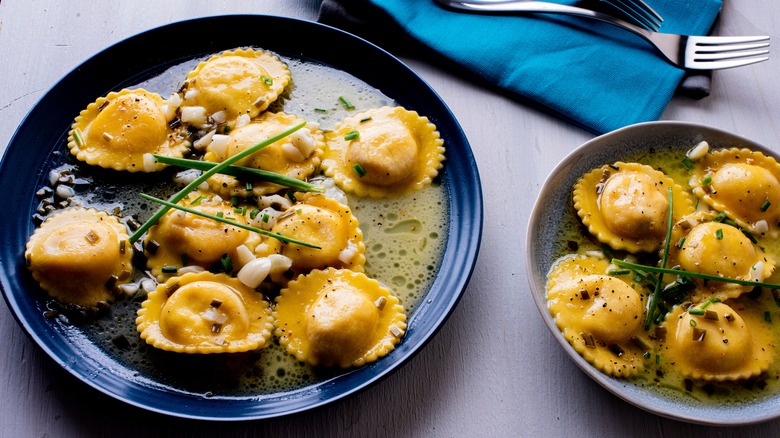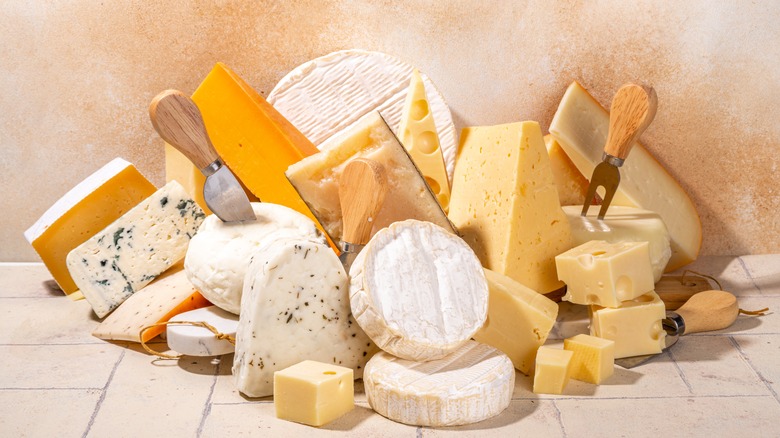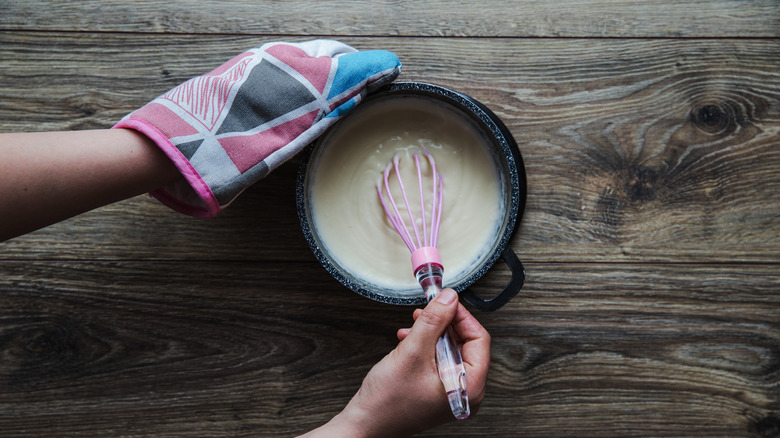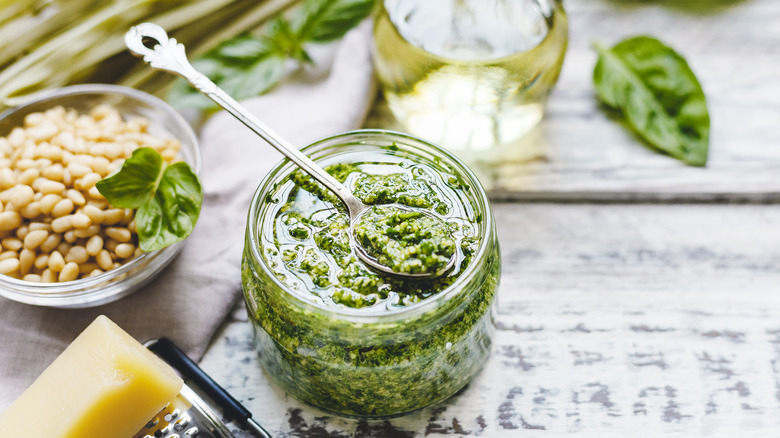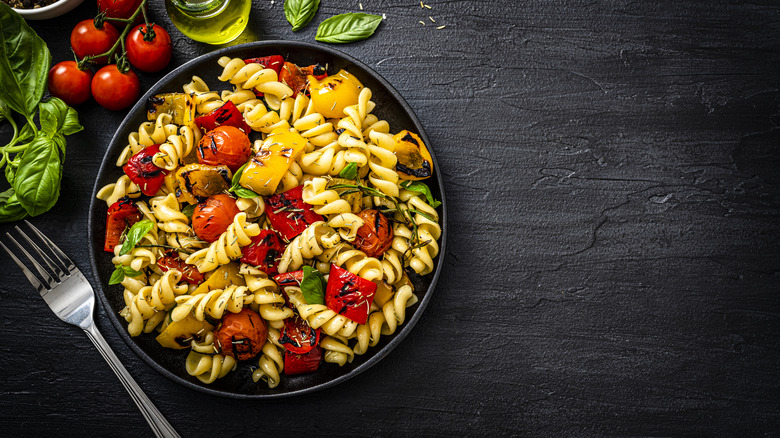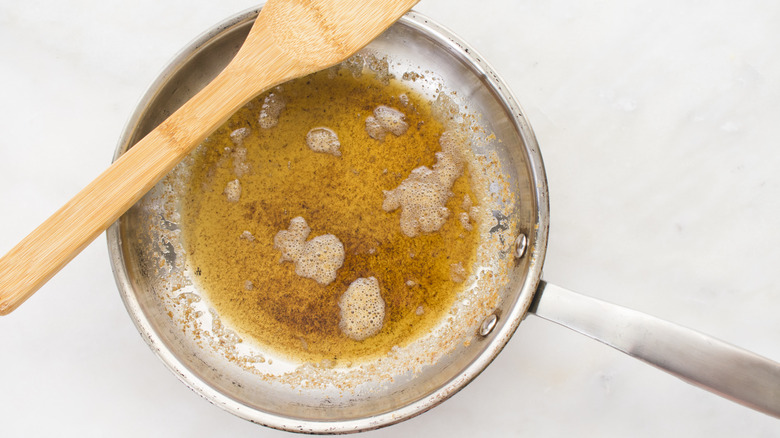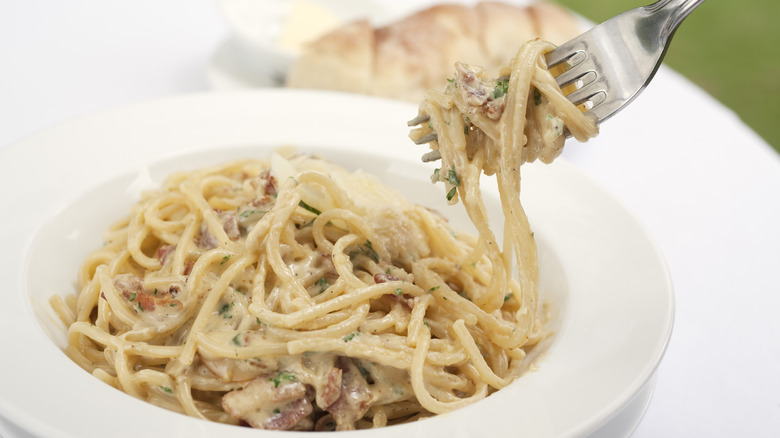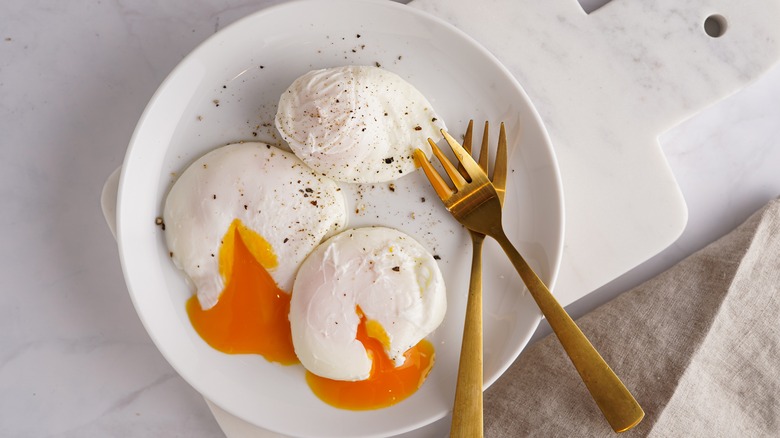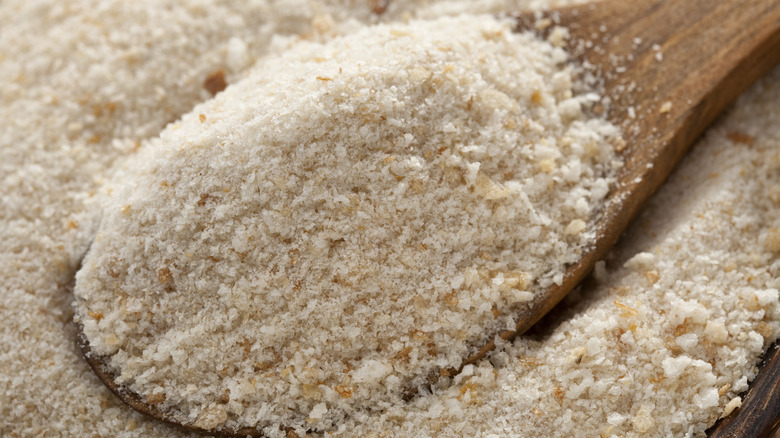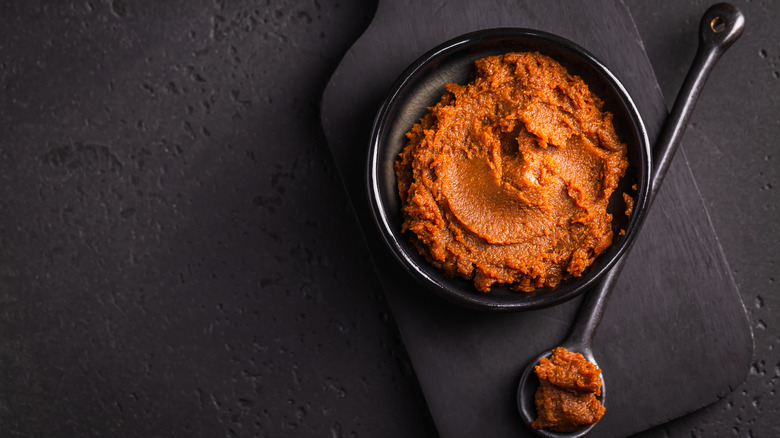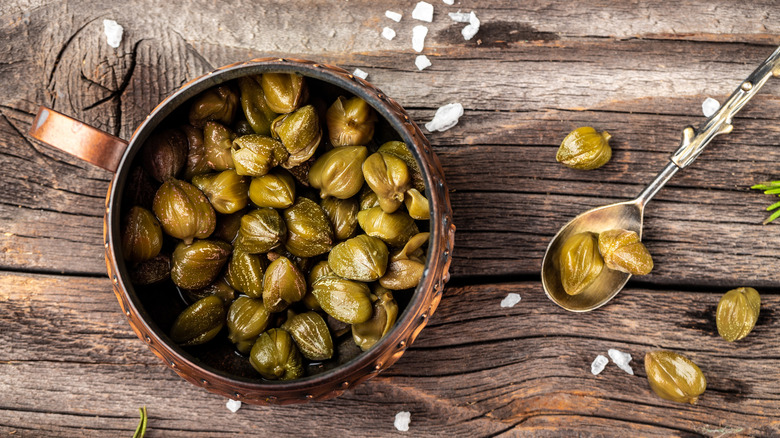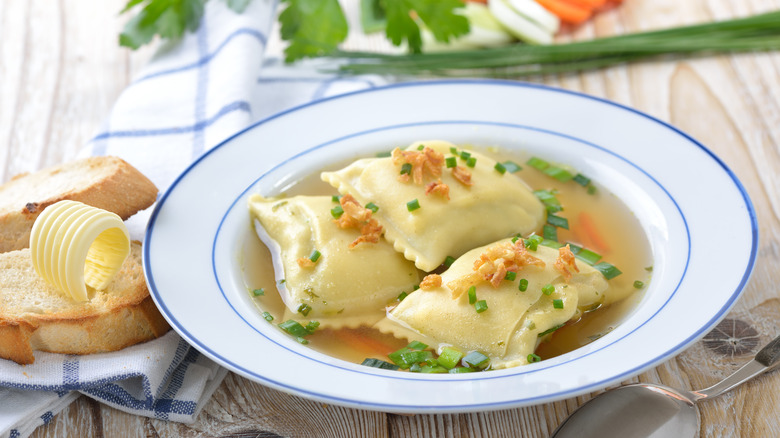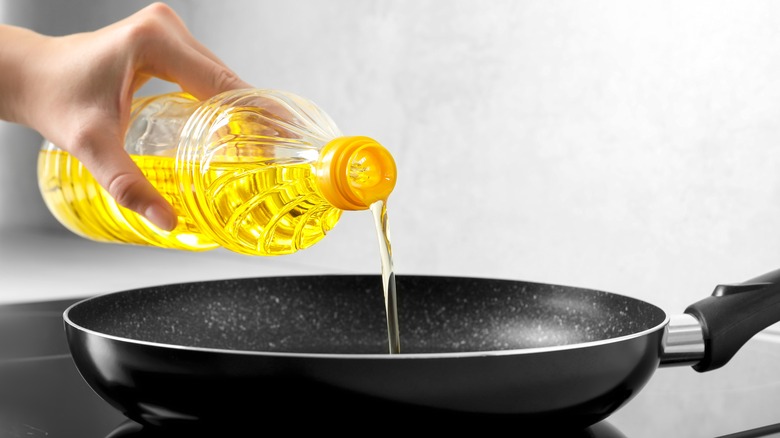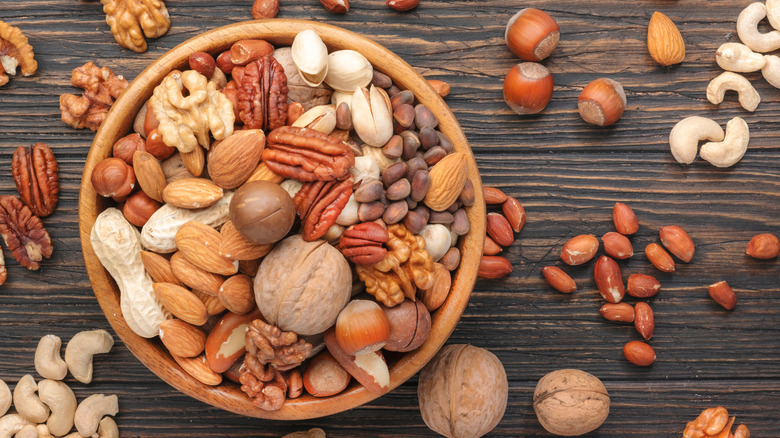How To Seriously Elevate Your Store-Bought Ravioli
When you're looking for a quick dinner that is a little more sophisticated than mac and cheese, ravioli is tough to beat. Whether purchased frozen, refrigerated, or canned, this versatile pasta is even easier to prepare than a peanut butter and jelly sandwich. Simply add it to boiling water, drain, and serve. If you have a few extra minutes, you can turn that bowl of ravioli into something truly special. Rather than being a quick weeknight meal for when your fridge is empty or you're too exhausted to cook, you can incorporate ingredients that will make your humble ravioli the perfect fit for any occasion, even a fancy dinner party.
From the ingredients that you probably already have in your pantry to the ones you might need to make a special trip to the store to procure, we've rounded up the best ways to make ravioli even more delicious. Our approach combines a thorough review of existing ravioli recipes with our expertise in cooking and recipe development. We sifted through the options to find the most popular flavor combinations that are both innovative and easy to apply to store-bought ravioli. In doing so, we've uncovered the special touches that can transform a simple bowl of ravioli into a restaurant quality meal without special equipment or extensive time in the kitchen.
Add cheese
You might think that cheese is too pedestrian an ingredient to radically transform a bowl of ravioli, but overlooking it would be a mistake. Cheese isn't just a garnish, it's a versatile and varied category that provides both flavor and texture. From the tangy creaminess of goat cheese to the saltiness of cheddar, there are options to fit any craving — and let's face it, we're always craving cheese.
If you're looking for a bold flavor, a few tablespoons of blue cheese will provide a pungent, earthy, and slightly sweet taste to your ravioli. If you want something with a broader appeal, simply sprinkle parmesan over the pasta for a salty umami taste. You could even put the dish under the broiler for a minute or two to create a crispy cheese crust. For pure luxury, look no further than burrata, which consists of a soft outer casing like mozzarella with a creamy liquid filling. When you slice the ball of cheese open, the rich interior will flow out like sauce to coat the ravioli.
Swap tomato sauce for béchamel
If you're used to pouring a jar of red sauce over freshly boiled ravioli, you'll be surprised by just how much the dish transforms when you use béchamel instead. One of the five "mother sauces" of French cuisine, béchamel is simple yet effective. Even though it is frequently found in recipes for lasagna, moussaka, and indulgent pasta dishes, it is not made with cheese. Instead, it is a simple combination of flour, butter, and milk that is heated and turned into a roux, a smooth mixture of flour and fat that forms the base of many sauces and gravies. Béchamel recipes frequently call for nutmeg, salt, and pepper, ensuring that the creaminess is enhanced and deepened by subtle flavors.
You can make your own béchamel without having to go out to buy special ingredients, but you can also purchase it in jars from the store. The beauty of béchamel is its creamy, velvety texture, which is even smoother than melted Gruyère. Its sophisticated flavor is subtle enough that it won't overpower the ravioli filling.
Use pesto instead of red sauce
Another easy alternative to tomato sauce is pesto. Made from a blend of fresh basil, garlic, pine nuts, parmesan, and olive oil, it provides a vibrant green hue and bright, zesty flavor that is a departure from the muted flavors of tomato sauce or béchamel. Nutty, cheesy, and full of the sharp, almost spicy taste of fresh garlic and basil, pesto is a dominant ingredient that pairs particularly well with hearty, neutral ravioli fillings like cheese, spinach, and mushrooms.
If you have extra time and don't mind making a special trip to the store to gather the ingredients, there is nothing like homemade pesto when the basil and garlic are at their freshest. You can even customize it, swapping the pine nuts with walnuts or almonds and the basil with arugula or spinach. There are, however, many ready-made versions that you can find at most stores that provide all the flavor you could need.
Add a few drops of truffle oil
We know, we know; truffle oil has been used to the point of cliché in recent years, and many foodies are ready to give it a break. But give us a chance to make our case, because we're pretty sure that this ingredient was made for ravioli. Known for its unmistakable earthy, umami-rich scent and flavor, truffle oil overpowers almost any dish it's paired with, which is why it works best when combined with muted flavors like french fries and polenta. Cheese or mushroom-filled ravioli will be transformed with only a few drops of this ingredient, adding layers of complexity and savoriness.
The main drawback of truffle oil is its price tag. You can't make it at home unless you have a ready supply of truffles, and lower-priced options often have little to no flavor. Luckily, a little goes a long way, so if you can splurge on a small bottle of the stuff, you'll be sure to have a steady supply of this miraculous ingredient for the foreseeable future.
Turn them into a gourmet pasta salad
Pasta salad gets a bad rap, probably because it's the go-to contribution to community potlucks and everyone's least favorite dish at the summer barbecue. But both pasta and salad are broad categories that encompass countless ingredient pairings and variations, and together, the possibilities are endless. Ravioli is not usually the pasta of choice, but there's no reason it can't be.
Pasta salad can be as basic or as fancy as you want. Even if you aren't a fan of penne, feta, and chopped veggies, you'll probably love a combination of cheese-filled ravioli, artichoke hearts, kalamata olives, lemon zest, and parmesan. If you want something earthier for the winter months, add roasted butternut squash, pine nuts, sage, and blue cheese. There is no shortage of ingredient options, and it doesn't have to be complicated. If you find yourself in a pinch for dinner, all you have to do is boil some ravioli and raid your fridge. You'll probably surprise yourself with the delicious and unique results.
Douse them in brown butter
Every type of pasta is crying out for some kind of sauce, even if it's just a dash of olive oil. As soon as you drain spaghetti, fusilli, or ravioli, the pieces begin to stick together until they've formed one gluey mass of dough. Pasta sauce is the most common solution, but there is another option that is just as simple as olive oil but much more flavorful: brown butter. Even though it is made with nothing but butter, brown butter is the secret weapon of many a home cook. It can transform everything from apple tarts to Turkish eggs, and ravioli is no exception.
Brown butter is made by slowly heating butter until the milk solids caramelize, producing a rich, nutty, slightly sweet sauce that tastes vastly more complex and intense than the ingredient it's made from. The main challenge of browning butter is to avoid burning it. A light-colored pan will help you monitor the color to ensure it doesn't get too dark, and transferring it immediately to a separate bowl will prevent it from continuing to cook once it's off the heat.
Make them with carbonara sauce
Although pasta is one of the most versatile starches you can build a meal around, it pairs particularly well with creamy, salty ingredients. And when it comes to that flavor profile, you can't beat carbonara. The luxurious sauce made of parmesan, raw eggs, and bacon (or guanciale if you want to follow the traditional recipe to the letter) is one of the most iconic ingredients in Italian cuisine, and it's easy to see why. Carbonara does not have the cloying, throat-clogging texture that some cream-based sauces do, providing instead a lighter, silkier consistency that coats the pasta without drowning it. This allows the savory, salty flavors of the cured pork and parmesan to shine through.
Making this savory sauce at home is easy as long as you have the ingredients on hand. Our simple pasta carbonara recipe takes only 25 minutes, including the time it takes to cook the pasta. You can pair the sauce with any type of ravioli, but the mild flavors of spinach, ricotta, and mushroom all create the perfect base for the bold flavors of carbonara.
Top each serving with a poached egg
Making ravioli from scratch is challenging and time-consuming, and luckily, you don't have to do it all yourself to enjoy more obscure ingredient combinations. This shortcut to uovo in raviolo is a prime example. Translated to "egg in ravioli" (or the singular "raviolo" to be exact) in Italian, uovo in raviolo is a large, single raviolo that encases a whole, raw egg yolk nestled in a ricotta, parmesan, spinach, and nutmeg filling. When you break the pasta casing with a fork, the yolk spills out like sauce.
You're unlikely to find readymade versions of uovo in raviolo at the supermarket, in part because raw egg yolks are tough to preserve. Thankfully, you can skip the headache of making it yourself with an easy workaround. Adding a lightly poached egg on top of cheese or spinach ravioli creates a respectable and infinitely less frustrating alternative to a homemade version that still provides the dramatic effect of the oozing egg yolk. You can even go the extra mile by serving the creation on a bed of ricotta, parmesan, spinach, and nutmeg.
Add breadcrumbs
Ravioli is pretty perfect on its own, thanks to the myriad possibilities for fillings. One thing it rarely has, however, is crunchiness. We're not saying that every dish needs a crunchy element, but there is something about textural variation that can turn a good meal into a great one. With this in mind, adding some crispy breadcrumbs to a bowl of ravioli is one of the easiest ways to make it seem fancier than it is. It also provides ample opportunity to incorporate even more flavor.
Homemade breadcrumbs are one of the easiest crunchy garnishes to make short of sprinkling your ravioli with crushed potato chips (which, if we're being honest, doesn't sound terrible). They're also a great option when you don't want to make a special trip to the grocery store since you probably have some bread and olive oil lying around. Simply blitz the bread in a blender, toss it in oil, and toast it in a skillet or oven. This easy formula can be made as fancy as you have time for. Minced garlic and red pepper flakes will give it a fragrant kick, while herbs, parmesan, and even a dash of garam masala will take things to the next level.
Use miso for a hint of umami
Incorporating miso into ravioli provides a hint of umami-rich flavor. The fermented soybean paste is commonly used in Japanese cooking and brings a surprising twist to the classic Italian dish. Many recipes use miso as a transformative ingredient, from mashed potatoes to salmon. It is also an ideal ingredient for people adhering to a vegan diet since its deep, savory flavor can take the place of meat. Our vegan carbonara recipe relies on it for this reason, but even if you aren't vegan, we're confident that you'll love how it tastes with ravioli.
If carbonara isn't your thing or you'd rather have a stronger taste of miso, you can incorporate the paste into a sauce made with nothing but butter and parmesan or dress it up with cream, garlic, and chili flakes. Using miso soup instead of paste is another option. You can buy cartons of it at many grocery stores, and the addition of ravioli creates a warming, hearty dish that is full of flavor.
Add capers
Although they are often overlooked, capers can pack as much of a transformative flavor punch as more famously forceful ingredients like truffle oil and anchovies. The small, round morsels are actually flower buds rather than berries that carry a vegetal flavor alongside their intensely salty tanginess. This makes them the perfect foil for rich ravioli fillings such as cheese and meat. Just a sprinkling can balance the heavy flavors with a touch of acidity and brininess.
You can keep it as simple as dumping a spoonful of capers over unseasoned ravioli, or you can incorporate the little green buds into a sauce. Chicken piccata is a common recipe that contains capers, and you can easily substitute ravioli for the chicken. Create a roux using butter and flour (our piccata recipe includes a little white wine as well), and add garlic, chicken stock, lemon juice, and, of course, capers. Pour the warm, decadent sauce over cooked ravioli and marvel at the tangy, buttery results.
Drizzle them with a sweet and tangy balsamic reduction
Given that balsamic vinegar originated in Italy, it's no surprise that it pairs deliciously with one of the nation's most beloved pastas. The powerful, tangy condiment brings a sweet acidity to the dish that complements the creamy filling and starchy pasta shell. It also provides a glossy, dark pattern of drizzled sauce that is so eye-catching that you could use it for the aesthetics alone. Garnish the dish with a sprinkling of chopped sage or thyme and you'll have a picture-perfect meal fit for a five-star restaurant.
There are many options for making a balsamic reduction. You could buy a ready-made one at the store or create your own by simmering balsamic vinegar and honey or brown sugar until it thickens. You can intensify the flavor by adding your favorite jam — be it fig, blackberry, or cherry. Although it isn't the most conventional condiment to add to ravioli, a balsamic reduction is surprisingly harmonious with the pasta, regardless of the filling.
Turn them into ravioli in brodo
In Italian, ravioli in brodo means "ravioli in broth," and though it might sound a bit dull, it can be a game-changing way to serve the pasta. It also happens to be so quick and easy you could do it in your sleep. All you need is a carton of broth (or homemade stock if you're feeling fancy), ravioli, and a few seasonings. This is a particularly delicious option with more delicate fillings like cheese, spinach, or butternut squash, as the broth will enhance the flavor without overpowering.
Beef, chicken, and vegetable stock are obvious broth options, but you can make it extra nutritious by using bone broth or even a can of veggie soup. Ravioli in brodo is perfect for the winter months or if you're battling a cold. It provides plenty of warmth and vitamins from the broth, and the pasta and its fillings are substantial enough that you won't need to supplement it with side dishes. It also keeps well in the fridge since the moisture from the broth prevents the pasta from becoming dehydrated and chewy.
Fry them
Frying can make almost any food taste good. Rubbery, tasteless calamari would not be one of the most popular appetizers if it wasn't fried. Slices of onion probably wouldn't be your go-to burger side if they weren't fried. And no one would be clamoring for sticks of potato if they weren't cooked in oil to create french fries. Given how much frying can transform unappetizing ingredients, it's no surprise that it can also elevate foods that are already delicious. Ravioli is a prime example.
Frying ravioli isn't just a matter of dropping the cooked pasta in hot oil. For the crunchiest most flavorful results, start by breading it. You can do this by dipping it in milk, buttermilk, or a milk and egg mixture before tossing it lightly in flour and breadcrumbs. Seasoning the breadcrumbs with spices and herbs will add even more flavor, but the process of frying provides enough excitement for your taste buds. If you're looking for a healthier option, you can make these in an air fryer instead of deep frying them. The results are crispy and delicious with a soft, gooey filling.
Top them with nuts
The secret to elevating your next bowl of ravioli may be lurking in your snack drawer. Just a few teaspoons of chopped nuts can turn a bland meal of pasta into a crunchy, flavorful detour from your usual routine without creating more dishes to wash. If you want to take the flavor up a notch, however, it's worth using an extra pan or skillet to roast the nuts and turn them into a fragrant, toasted garnish.
You can use any type of nut, though walnuts, pecans, and pine nuts taste especially delicious when toasted. They blend well with cheese-based fillings, offering a contrast of textures while adding to the richness. The only downside to this option is that it doesn't offer much color contrast unless you use pistachios, but you can easily solve this aesthetic issue by adding wilted greens or fresh herbs. Another option is to turn the nuts into a sauce. Cashews are known for their creaminess when blended, while walnuts can form the foundation of a rich, flavorful, dairy-free sauce.
